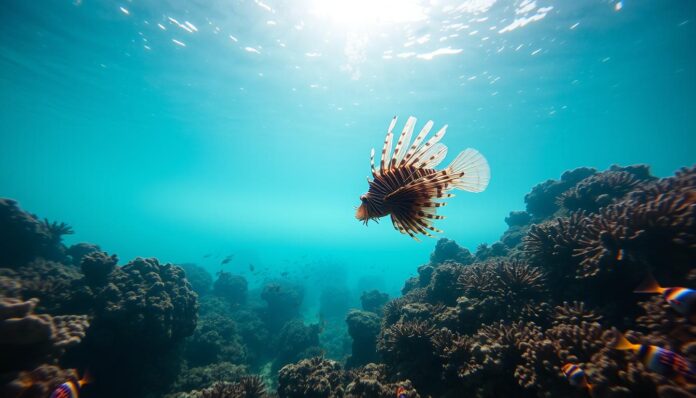Did you know over 2,200 lionfish have been removed by a single marine station? This action stopped millions of eggs from harming marine life. Scuba diving with lionfish is now a key way to protect our oceans while having fun.
Scuba diving with lionfish is an amazing experience. These colorful but harmful fish are a big problem in the Caribbean and Western Atlantic. Divers can help by joining in on lionfish hunting trips.
Underwater photography and diving responsibly have changed a lot because of lionfish. Now, divers can help protect the sea while having an exciting adventure.
Key Takeaways – Diving with Lionfish
- Lionfish culling is a critical conservation strategy
- Scuba diving experiences can directly contribute to marine ecosystem protection
- Specialized tours offer opportunities for responsible marine interaction
- Underwater photography can help raise awareness about invasive species
- Divers play a critical role in managing marine biodiversity
What Are Lionfish?
Lionfish are fascinating marine predators that have caught the eye of many. They are not only beautiful but also pose dangers in the sea. Marine biologists and underwater fans find them intriguing.
Lionfish belong to the Scorpaenidae family. They are known for their striking looks and the dangers they pose. Their bright red, brown, and white stripes make them stand out underwater.
Overview of Lionfish Species
There are several lionfish species, but Pterois volitans and Pterois miles are the most common. These species have traits that make them unique in the sea:
- Fully mature lionfish can reach 30-38 cm in length
- Capable of weighing up to 1.2 kg
- Possess 11 dorsal fin spines and 7 anal fin spines
- Can live between 5 to 15 years
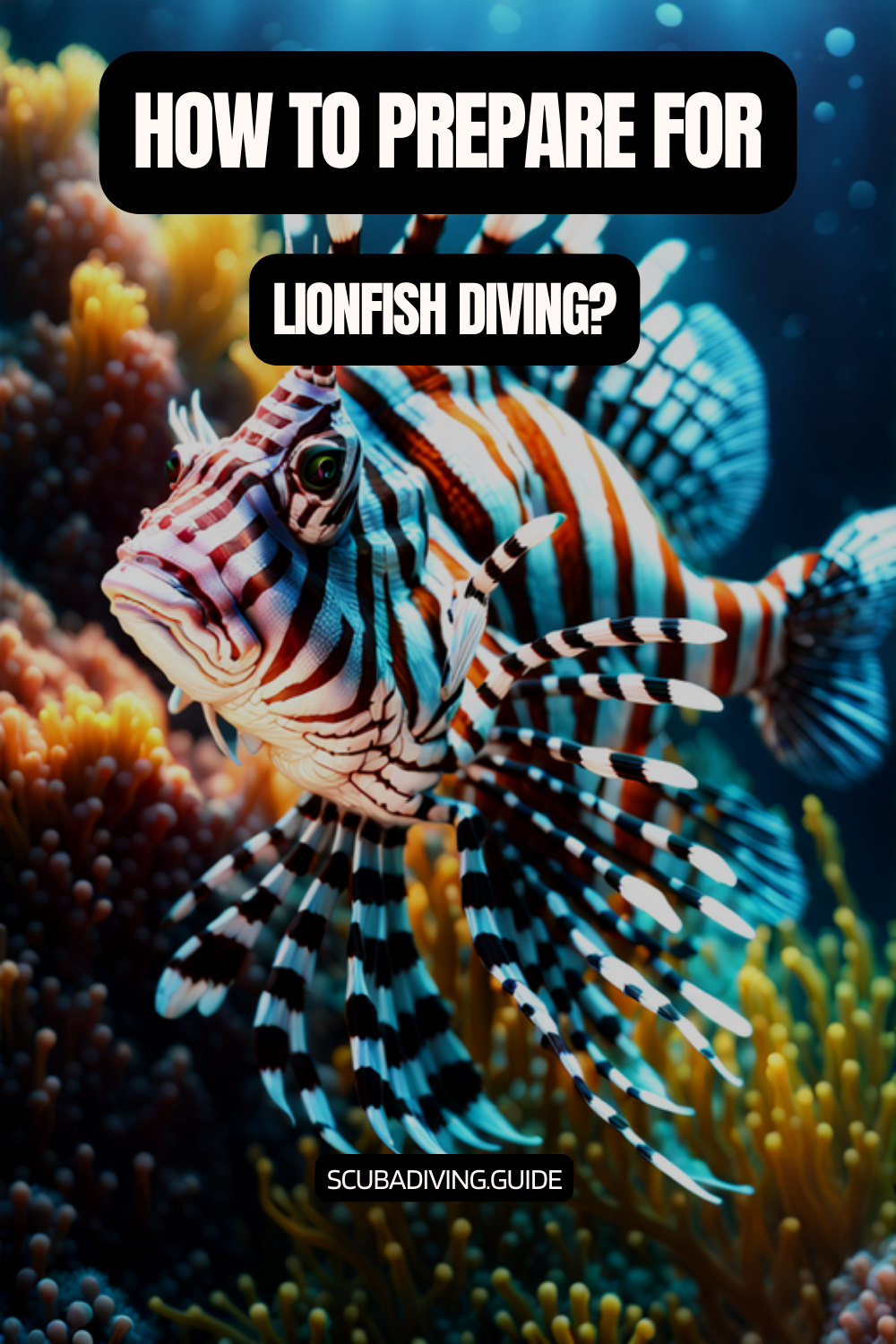
Unique Characteristics of Lionfish
Lionfish have amazing reproductive abilities. Female lionfish can lay up to 2 million eggs a year. Each spawn can produce 4,000 to 30,000 eggs. Their larvae grow fast, reaching 10-12 mm before settling.
“Lionfish are not just predators; they’re ecological game-changers.” – Marine Ecology Research Institute
Lionfish are skilled hunters. One lionfish can eat up to 20 fish in 30 minutes. This hunting skill can reduce native fish populations by up to 90% in some areas.
Knowing about lionfish is important for divers and sea lovers. These beautiful yet dangerous creatures continue to fascinate and challenge our understanding of the sea.
Importance of Lionfish in the Ecosystem
Lionfish are a big problem in marine ecosystems, mainly where they’ve invaded. Their special traits and aggressive hunting affect marine life and conservation.
Role in Marine Biodiversity
Lionfish have a huge impact on marine ecosystems. Studies show their effects are quite striking:
- A single lionfish can reduce native reef fish recruitment by 79%
- Over 90% of invasive lionfish in North America are Pterois volitans species
- Seven coral species have been listed as endangered in lionfish-infested areas
Lionfish Predation and Competition
Lionfish are top predators that upset local food chains. They hunt with incredible skill:
- Consuming prey up to 30 times their stomach size
- Capable of surviving weeks without food
- Producing up to 2 million eggs annually
“Lionfish represent an unprecedented ecological challenge in marine conservation efforts” – NOAA Research Team
Efforts to control lionfish are key to marine conservation. Eco-tourism also plays a role in managing their numbers. Local actions have shown to be effective.
| Lionfish Ecological Impact | Quantitative Measure |
|---|---|
| Native Reef Fish Recruitment Reduction | 79% |
| Annual Egg Production | 2 Million |
| Prey Size Consumption Ratio | 30:1 |
It’s vital to grasp lionfish’s role in ecosystems. This knowledge helps in creating effective conservation plans and eco-tourism that protects marine life.
Where to Find Lionfish When Diving
Scuba diving with Lionfish is now a thrilling eco-tourism activity. It attracts those who love unique marine experiences. These invasive predators have made diving adventures exciting in many places, opening up new areas for divers to explore.
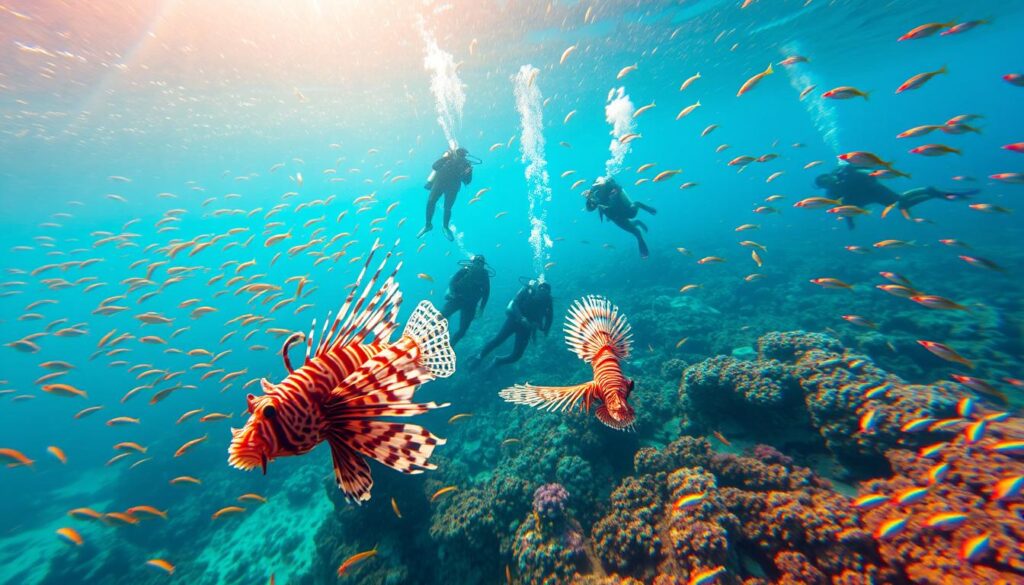
Lionfish have spread a lot in the Caribbean, Atlantic, and Mediterranean. This gives divers many chances to see them. Knowing where they like to be can make your dives even better.
Top Dive Destinations for Lionfish
Asia:
- Red Sea, Egypt: The Red Sea is renowned for its stunning coral reefs and diverse marine life, including lionfish. Popular dive sites like Ras Mohammed National Park and the Straits of Tiran provide excellent opportunities for encountering these mesmerizing creatures.
- Bunaken Marine Park, Indonesia: Located in North Sulawesi, Bunaken Marine Park is home to an incredible array of marine species, including lionfish. The park’s crystal-clear waters, vibrant coral walls, and steep drop-offs make it an ideal destination for lionfish dives.
- Sodwana Bay, South Africa: Sodwana Bay is a marine protected area in South Africa that boasts vibrant coral reefs and diverse marine ecosystems. Divers exploring the area have the chance to encounter lionfish while exploring the underwater beauty of this pristine destination.
Caribbean:
- Bonaire: Known as a diver’s paradise, Bonaire in the Caribbean offers exceptional diving experiences. The island’s Marine Park features healthy reefs teeming with marine life, including lionfish. Dive sites like Klein Bonaire and the Salt Pier provide excellent opportunities for observing these captivating creatures.
- Cozumel, Mexico: Cozumel’s world-class dive sites offer thrilling encounters with lionfish. The island’s stunning coral formations and strong currents create an ideal habitat for these intriguing creatures. Divers can explore sites like Palancar Reef and Santa Rosa Wall to witness the beauty of lionfish in their natural environment.
- Bay Islands, Honduras: The Bay Islands, including Roatan and Utila, are renowned for their pristine coral reefs and abundant marine life. Divers visiting these islands can encounter lionfish while exploring the breathtaking underwater landscapes and enjoying the warm Caribbean waters.
- Azores, Portugal: The Azores archipelago, located in the Atlantic Ocean, offers remarkable diving opportunities, including encounters with lionfish. The volcanic formations, clear waters, and rich biodiversity make the Azores a captivating destination for divers seeking to observe these fascinating creatures.
- Great Barrier Reef, Australia: The Great Barrier Reef is a UNESCO World Heritage Site renowned for its unparalleled marine biodiversity. While exploring this iconic destination, divers may come across lionfish along with a multitude of other fascinating marine species.
North America:
- Florida Keys, United States: The Florida Keys, with their vibrant reefs and warm waters, provide excellent opportunities for diving with lionfish. Divers can join organized lionfish culling events to help control their population while enjoying the beauty of this renowned diving destination.
- Galapagos Islands, Ecuador: The Galapagos Islands are a unique and remote diving destination, offering encounters with an abundance of marine life, including lionfish. Divers can explore the stunning underwater landscapes and witness the fascinating interactions between lionfish and other endemic species.
It is important to note that lionfish populations can vary in different regions and are subject to ongoing monitoring and control efforts. Always ensure you follow local regulations and guidelines to promote responsible diving practices and contribute to conservation efforts.
In conclusion, these destinations offer divers the opportunity to embark on thrilling adventures and encounter lionfish in their natural habitats. Whether exploring the Red Sea’s majestic reefs or diving in the crystal-clear waters of the Caribbean, diving with lionfish provides a unique and memorable experience for underwater enthusiasts.
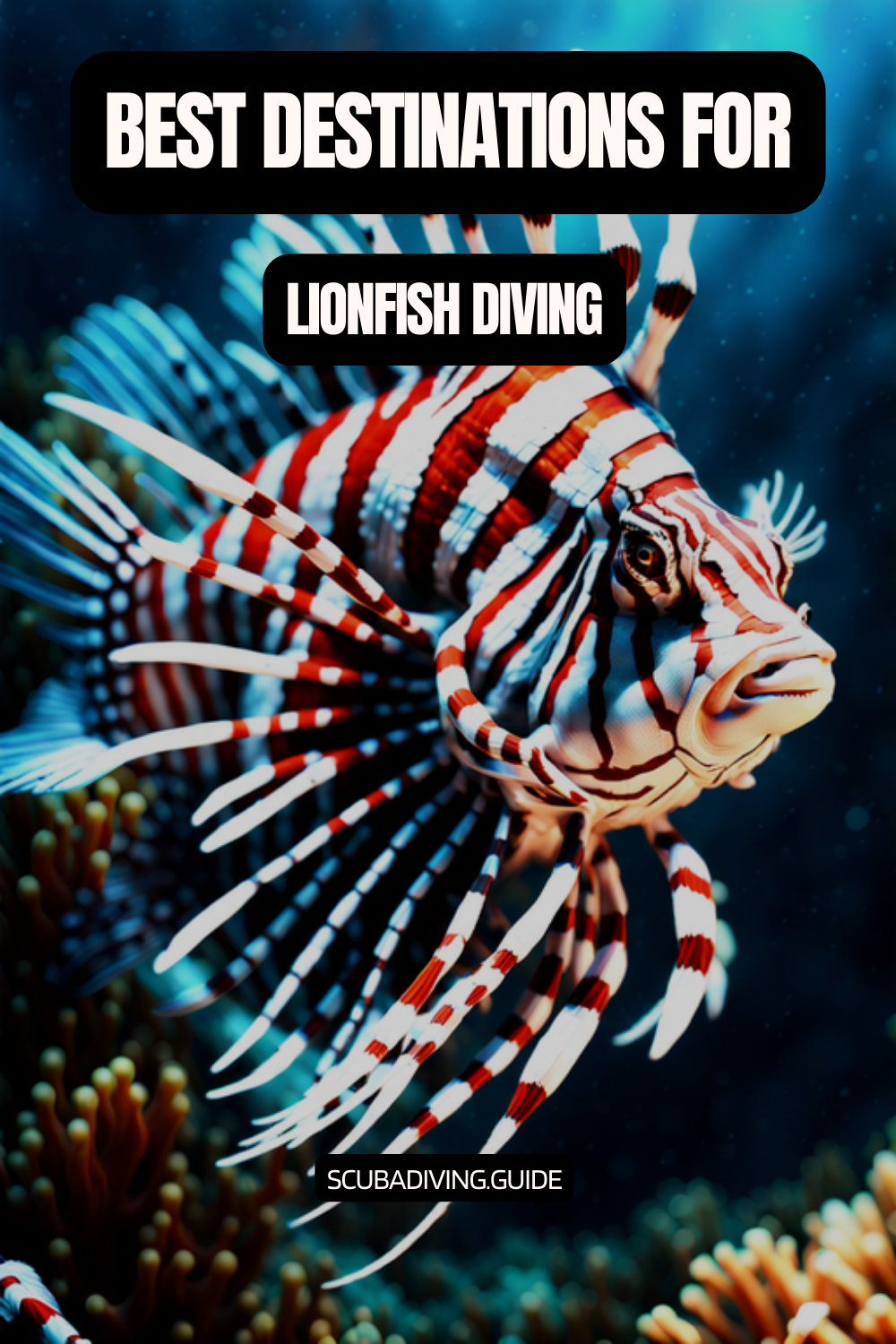
Best Seasons for Lionfish Sightings
| Region | Peak Lionfish Season | Water Temperature |
|---|---|---|
| Caribbean | March-September | 78-82°F |
| Florida Keys | April-October | 75-85°F |
| Bahamas | May-November | 77-84°F |
For those diving with Lionfish, be ready for different underwater worlds. Coral reefs and rocky areas are the best places to find them.
“Hunting lionfish isn’t just an adventure—it’s a conservation effort.” – Marine Ecosystem Specialist
Many dive operators now offer lionfish hunting trips. These trips turn encounters with these fish into important eco-tourism activities. Some places, like Bonaire, need special training and guides for safe lionfish interactions.
Safety Precautions When Diving with Lionfish
Scuba diving with lionfish needs careful attention to dangers from venomous fish. These beautiful but harmful marine creatures require respect and understanding from divers. This ensures a safe underwater experience.
Lionfish have an impressive defense with 18 venomous spines. Knowing their anatomy is key for safe diving.
Understanding Lionfish Venom
The lionfish’s venomous spines are found in different parts of their body:
- 13 long venomous spines on the dorsal fin
- 2 short venomous spines on each pelvic fin
- 3 additional venomous spines along the anal fin’s front edge
Tips for Avoiding Stings
To avoid lionfish stings, dive carefully and stay aware. Safe diving practices mean keeping a safe distance and knowing lionfish behavior.
“Prevention is always better than treatment when encountering marine wildlife.” – Marine Safety Expert
First Aid for Lionfish Stings
| Action | Recommendation |
|---|---|
| Immediate Treatment | Soak sting wound in hot water (40°C) for 30 minutes |
| Medical Follow-up | Contact DAN Emergency Hotline: +1 (919) 684-9111 |
| Pain Management | Use painkillers and anti-inflammatory medications |
While serious problems from lionfish stings are rare, quick and right action can lessen risks. This is important for safe encounters with these venomous fish.
Best Practices for Interacting with Lionfish
Diving with lionfish is a delicate mix of curiosity and respect. It’s key for divers to keep the environment safe while taking amazing photos.
When you meet lionfish, you need to be careful and plan ahead. Experts say there are special ways to stay safe and protect the sea.
Responsible Approach Techniques
- Maintain a safe distance of at least 3-4 feet from lionfish
- Never touch or provoke lionfish during underwater encounters
- Use slow, deliberate movements to avoid startling the fish
- Observe lionfish behavior without disrupting their natural habitat
Underwater Photography Tips
To get great lionfish photos, you need special skills. Here’s what pros suggest:
- Use macro lens for detailed close-up shots
- Adjust camera settings for low-light marine environments
- Position yourself at eye level with the lionfish
- Utilize natural background to highlight lionfish characteristics
“Responsible diving is about observation, not interference.” – Marine Conservation Expert
Culling and Conservation Efforts
| Location | Lionfish Removed | Program Cost |
|---|---|---|
| Belize | 12,000 (Hamanasi) | $55-$1,200 |
| ReefCI | 7,000 in one year | Research-based |
Divers are key in controlling lionfish numbers. By following the right code, they help protect the sea and have amazing dives.
The Excitement of Lionfish Hunting
Lionfish hunting is key to saving marine ecosystems. These invasive fish can harm native fish and cut reef biodiversity by up to 90%.
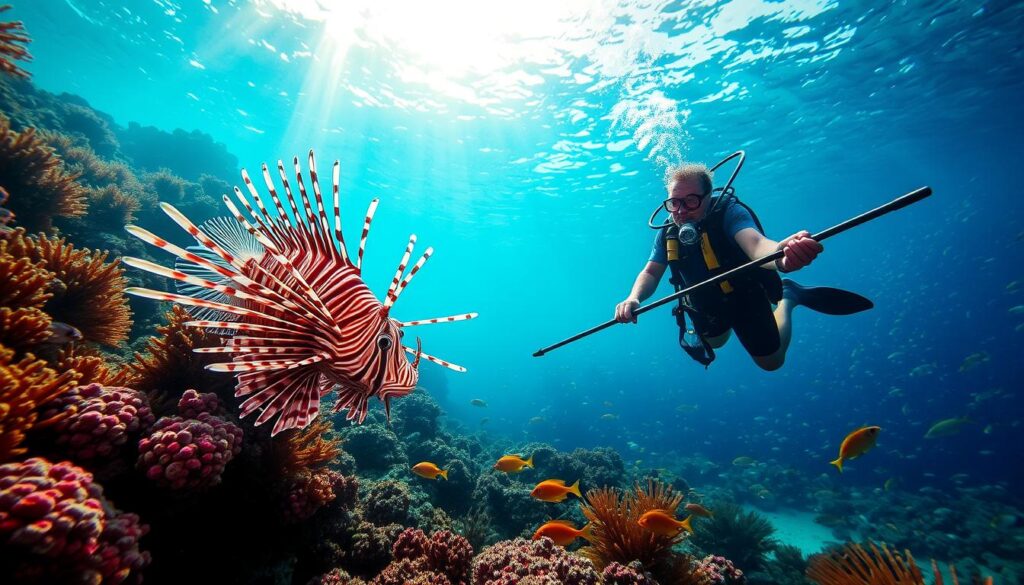
Divers and marine experts use special methods to fight lionfish. This effort protects the ocean while giving divers a thrilling underwater journey.
Conservation Efforts and Regulations
Lionfish hunting rules differ by place. But most places want people to remove them to save the sea. Here are some main rules:
- No current bag limits for lionfish catches
- Recommended use of specialized spearing equipment
- Participation in organized removal events
“Every lionfish removed is a victory for marine conservation” – Marine Biologist Research Team
Gear Needed for Lionfish Hunting
To hunt lionfish well, you need the right gear. It keeps you safe and helps you catch them effectively. Here’s what pros suggest:
| Equipment | Purpose |
|---|---|
| Puncture-resistant gloves | Protection from venomous spines |
| Specialized spear | Precise lionfish removal |
| Containment bag | Safe storage of captured lionfish |
A team of four divers can catch about 32 lionfish in a few hours. The hunting depth can go up to 110 feet in places like the Gulf of Mexico.
By joining lionfish hunts, divers get to have fun underwater. They also help protect the ocean.
Environmental Impact of Lionfish
Lionfish are a big problem for marine ecosystems, mainly in the Atlantic Ocean and Caribbean Sea. They upset the balance of nature, making it hard to protect the sea.
The harm caused by lionfish is huge and complex. Their fast growth and hunting skills hurt marine life a lot.
Invasive Species Concerns
Lionfish can reproduce very quickly, making them a big threat:
- A single female can spawn up to 30,000 eggs every four days
- Annual egg production exceeds 2 million per female
- Reproduction occurs year-round
- Larvae can travel extensive distances via ocean currents
Impact on Local Ecosystems
Studies show lionfish are causing big problems in marine ecosystems:
| Ecosystem Impact | Percentage |
|---|---|
| Native Fish Community Reduction | 65% in two years |
| Maximum Observed Fish Decline | 95% in specific locations |
| Predation Capability | Consume prey larger than 50% of their size |
“Lionfish are transforming marine ecosystems faster than we can comprehend.” – Marine Ecology Research Institute
Lionfish mainly eat fish that keep algae in check. This hurts coral reefs, making it key to manage lionfish.
To fight this, we’re using lionfish derbies, promoting eating lionfish, and working together globally to find ways to control them.
Lionfish Cooking and Culinary Uses
Lionfish are now a tasty way to help the ocean. Dive teams and locals are eating them to fight against lionfish. This is a smart way to manage the sea.
Preparing Lionfish for Consumption
It’s important to handle lionfish carefully because they have eighteen venomous spines. Chefs say to:
- Wear gloves when cleaning
- Remove venomous spines before cooking
- Cook them well to get rid of toxins
“Eating lionfish is a delicious way to help marine conservation” – José Andrés
Popular Recipes Featuring Lionfish
Lionfish taste like mahi-mahi, which is great for many dishes. They’re also a hit in eco-tourism, thanks to special cooking tours.
| Cooking Method | Flavor Profile | Recommended Ingredients |
|---|---|---|
| Ceviche | Citrusy, Fresh | Lime juice, coconut, jalapeño, Valencia oranges |
| Baked | Mild, Delicate | Herbs, lemon, garlic |
| Stir-Fry | Savory | Vegetables, soy sauce, ginger |
The Roatan International Lionfish Tournament shows how food can help the sea. By eating lionfish, we turn a problem into a tasty solution.
Common Marine Species Found Alongside Lionfish
Diving with lionfish offers an opportunity to explore the vibrant and diverse underwater ecosystems where these captivating creatures reside. While encountering lionfish is a thrilling experience on its own, divers often come across a wide array of marine species that coexist with them. Let’s explore some of the common marine species found alongside lionfish:
- Reef Fish: Lionfish are often found inhabiting coral reefs, where they share their habitat with a variety of colorful reef fish. Divers may come across species such as angelfish, butterflyfish, parrotfish, wrasses, and triggerfish, among others. The vibrant hues and diverse patterns of these reef fish create a mesmerizing spectacle alongside the lionfish.
- Eels: Eels are frequently encountered in the same areas as lionfish. Moray eels, with their elongated bodies and sharp teeth, are known for their intriguing appearance. Divers may observe them peeking out from crevices or swimming gracefully in search of prey. The coexistence of eels and lionfish adds to the allure of the underwater environment.
- Stingrays: Stingrays often glide effortlessly through the sandy bottoms near reefs, creating a graceful sight alongside lionfish. These flat-bodied creatures, with their undulating movements and distinctive shape, offer divers a glimpse into their mysterious world. Observing stingrays in their natural habitat is a memorable experience during lionfish dives.
- Crustaceans: Divers exploring lionfish habitats may encounter various crustaceans, adding to the diversity of marine life. This includes species such as shrimp, crabs, and lobsters. Their intricate forms, unique behavior, and ability to blend with their surroundings make them fascinating subjects for observation and underwater photography.
- Coral Species: Lionfish are often found residing among vibrant coral formations. Divers can marvel at the exquisite beauty of hard corals, soft corals, and sea fans that serve as the backdrop for these encounters. The colors, shapes, and textures of corals create a visually stunning environment, providing a rich and diverse ecosystem for lionfish and other marine species.
- Turtles: Sea turtles, such as green turtles, hawksbill turtles, or loggerhead turtles, may also be encountered during lionfish dives. These gentle giants gracefully glide through the water, occasionally surfacing for air. Observing these magnificent creatures alongside lionfish adds to the wonder of the underwater experience.
- Other Predatory Fish: In addition to lionfish, divers may come across other predatory fish that share the same hunting grounds. This can include species such as groupers, barracudas, or jacks. Witnessing the interactions between these predators and their prey creates a dynamic and thrilling scene underwater.
Encountering these diverse marine species alongside lionfish showcases the interconnectedness of marine ecosystems. The coexistence of various organisms highlights the importance of preserving these habitats and maintaining a balanced underwater environment.
Conclusion: Why Scuba Dive with Lionfish?
Scuba diving with lionfish is a unique chance to help marine conservation. These fish, introduced to the Atlantic in the 1980s, have changed underwater worlds. Divers can directly help protect the ocean by diving with them.
Being a responsible diver when meeting lionfish is key. Studies show divers can remove up to 75% of lionfish from reefs. This helps control their numbers and supports the ocean’s health.
Summary of Key Benefits
Lionfish diving offers more than just fun. It helps reduce the threat to native sea life. Lionfish eat up to 80% of young fish in just five weeks. Every dive helps protect the ocean and its creatures.
Encouragement to Dive Responsibly
When diving with lionfish, your actions can make a big difference. Always follow safety rules and use the right gear. Your care for the ocean can inspire others and help global conservation.
FAQ – Diving with Lionfish
Are lionfish dangerous to divers?
Lionfish have venomous spines that can cause painful stings. While not typically life-threatening, their venom can cause severe pain and swelling. In rare cases, it can lead to more serious reactions. Divers should keep a safe distance and avoid direct contact with lionfish to prevent injuries.
Where are lionfish most commonly found?
Lionfish are native to the Indo-Pacific region. They have become invasive in the Caribbean Sea, Gulf of Mexico, and along the Atlantic Coast of the United States. Popular diving locations include the Florida Keys, Belize, and various Caribbean islands where they have significantly impacted local marine ecosystems.
Can I hunt lionfish while diving?
Yes, many areas encourage lionfish hunting as a conservation method. Divers must follow local regulations, obtain necessary permits, and use appropriate specialized equipment. Always check local guidelines before attempting to hunt lionfish.
How can I protect myself from lionfish stings?
Protect yourself by maintaining a safe distance and wearing protective diving gloves. Use proper diving techniques. If accidentally stung, remove any spine fragments, clean the wound, and apply hot water to neutralize the venom. Seek medical attention if you experience severe symptoms or allergic reactions.
Are lionfish good to eat?
Absolutely! Lionfish are considered a delicious seafood option with white, flaky meat. Eating lionfish supports conservation efforts by helping to control invasive populations. Many restaurants and local communities have developed creative recipes that showcase this sustainable seafood choice.
How do I photograph lionfish underwater?
For the best lionfish photography, use a macro lens and ensure good lighting. Approach carefully without disturbing the fish. Use a slow, steady approach, and consider using natural reef backgrounds to highlight the lionfish’s unique coloration and details.
Why are lionfish considered an invasive species?
Lionfish reproduce quickly and have no natural predators in non-native ecosystems. They are highly efficient predators. They can consume large numbers of native fish species, disrupt local food chains, and negatively impact coral reef health and marine biodiversity in invaded areas.
What equipment do I need for lionfish diving?
Essential equipment includes standard scuba gear, protective gloves, and a dive light for better visibility. If you’re participating in lionfish hunting, you may need a specialized spear or collection device. Always ensure you have proper training and follow local diving regulations.
